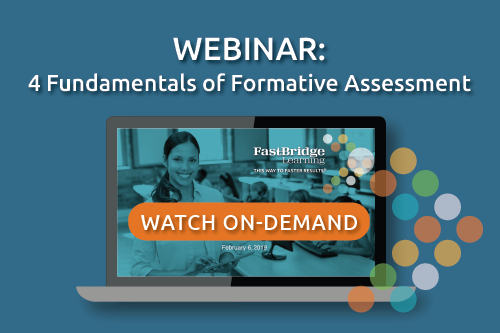Educators often ask me the right way to assess student learning and growth. Unfortunately, as with most complex questions, the correct answer is, “it depends.” The answer depends on the question you have about student learning. A different assessment may be needed if you want to determine who is at risk of reading failure than if you want to learn how many students met standards at the end of the last school year. While there are a variety of assessments used in schools, most of these fall into one of two categories: (a) summative and (b) formative.
Summative assessment is the process of evaluating learning at the end of a specific period of instruction. This often occurs at the end of a unit, course, or school year. Formative assessment, on the other hand, is used during instruction, and provides feedback to allow for the adjustment of teaching to match students’ current learning needs. Let’s explore more about why educators use both formative and summative assessment through the lens of the questions that data are designed to answer.
Using Student Data to Ask Better Questions
As educators we aren’t always aware that when we use data we’re actually asking, and answering, many questions. Those questions occur at both the student and group level, with teachers typically asking questions at the student level, and building and district leaders often asking questions at a group level. For instance, we can use data to inform instruction at the individual student level by asking questions like these:
- Is Berta on track to meet expectations on the third-grade summative assessment?
- Does Will need additional teaching to learn to divide multi-digit numbers?
- How many grade levels should we accelerate Tanya for reading instruction?
Additionally, we use data to make decisions regarding groups of students, often at the grade or school level. For instance, we can ask many questions about groups of students, including:
- Which grade levels in our school currently need the most intervention resources?
- Is the universal tier instruction meeting the needs of our students in each grade level in our building?
- Which grade levels need a whole group intervention?
One challenge educators face is ensuring that the types of data available match the questions that everyone in the system needs to answer. For instance, if all we have is the end of the year, state summative assessment, teachers won’t be able to answer the questions they have about individual student needs. In contrast, if all we have are teacher-developed assessments pinpointing individual student instructional needs, district leaders will be left with unanswered questions in their work. Because of this, schools need assessment data that allow them to make both formative and summative decisions.
At times I hear educators complain that they collect tons of data, but the scores are not helpful. Often, this type of frustration about data results when schools are using multiple assessments that collect the same kind of data, rather than having data from multiple types of assessments that allow them to answer all their questions.
In Defense of the Summative Assessment
Summative assessment has gotten a bad reputation, ever since No Child Left Behind. A large part of this may have been because school ratings (and financial consequences) were based on certain required summative assessments. If schools had easily been able to meet the rigorous growth expectations set forth in NCLB, I don’t believe we would’ve seen an outcry against the legislation or testing.
Summative assessment took the heat of public opinion when, in reality, summative assessment itself is not the problem. It simply informs educators and the public about trends in current student outcomes. That said, summative data cannot answer questions about individual student learning needs. When considering data at a broad scale, such as district, or statewide, summative assessment is helpful to answer many of the questions educators, and the public, pose.
However, for day to day questions, and questions about instructional needs, formative assessment is the type of assessment to use.
Why Formative Assessment
Formative assessment includes data collected multiple times during instruction in order to adjust practice. Educators generally want such data in order to inform their instruction. What is often not discussed, though, is that there are multiple types of formative assessment, and how they are similar and different. Formative assessment can be both informal and formal in nature.
First, there are formative assessments that teachers are conducting every day, with all students. These are often informal in nature and occur during instruction. Teachers develop them based on the specific content covered and use them to determine immediate instructional needs.
For example, a teacher may ask all students to write the answer to a question on a white board and hold them up. The teacher can see which and how many students have the answer correct and can use this information to determine whether to reteach a concept or continue to the next part of a lesson. This type of assessment is informal, can happen frequently during instruction, and is used with all students. It allows the teacher to adjust instructional plans based on student learning, and provide more intensive scaffolding when needed, or recognize that students are accurate with a skill and are ready for more practice with the skill, potentially with peers.
In contrast, there is another type of formative assessment that is more formal in nature. This type of formative assessment often uses various curriculum-based measures (CBM). It is still brief, and is used to modify instruction when needed, but it is standardized across all students, and often occurs outside of instruction. These forms of formative assessment are typically determined at the school or district level. FAST™ serves as a formal formative assessment in many districts.
When used with all students, formal formative assessment is called universal screening. Teachers use this to identify which students are at risk in reading, math, or social-emotional behavior for the purpose of providing additional instruction to close small learning gaps before they become large. This type of formative assessment can also used with selected students who are struggling to achieve grade-level standards and for whom additional instruction is being provided to close their learning gap. This is referred to as progress monitoring and occurs regularly and frequently to allow educators to intensify instruction when students are not being successful with their current instructional package. It’s important that a standardized, valid and reliable formative assessment be used in these cases, so that the data can be reviewed regularly in order to monitor student learning progress.
A Comparison
Although not called formative assessment, health professionals regularly use formative assessment to help us stay healthy. Starting with well-child check-ups, they make sure our physical growth and developmental milestones are met. These well-child check-ups are synonymous with the universal screening many schools conduct multiple times per year with all students.
When our children are sick, we take their temperature frequently to ensure medications are helping and they’re healing. This is similar to our construct of formal progress monitoring. We can informally use our hand to tell if our child may or may not have a fever, but once we know that he’s sick, we switch to a thermometer to give us the more formal measure.
How FAST is Part of a Comprehensive Assessment System
FAST serves many schools by providing a formative assessment system that has demonstrated reliability and validity for both universal screening and progress monitoring purposes. It supports district and building leaders to answer questions at a group level, as well as tools for teachers to answer questions about individual student needs.
To learn more about FAST or to request a demo, contact us.








